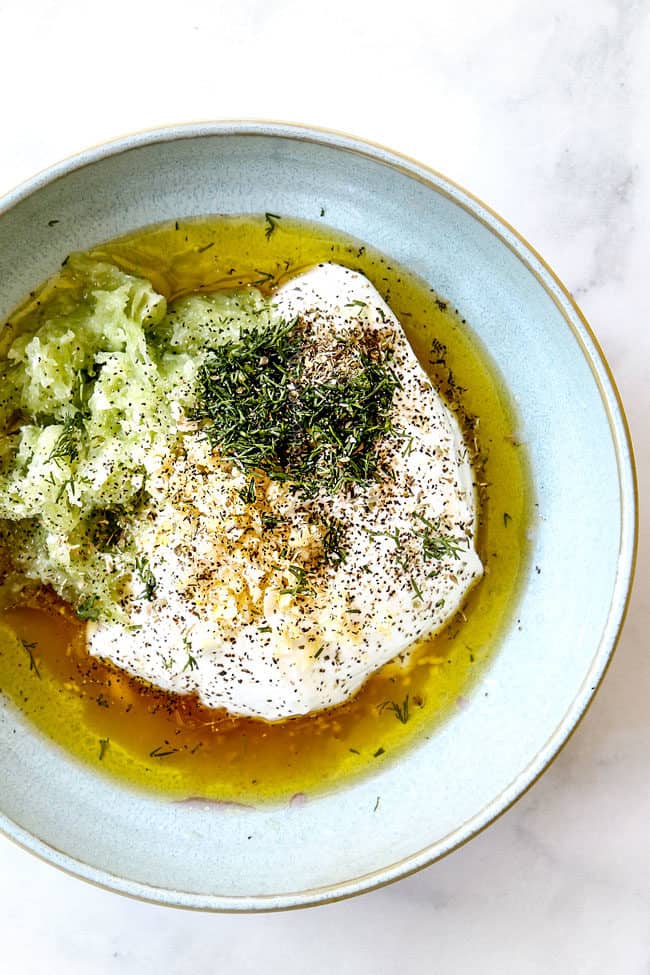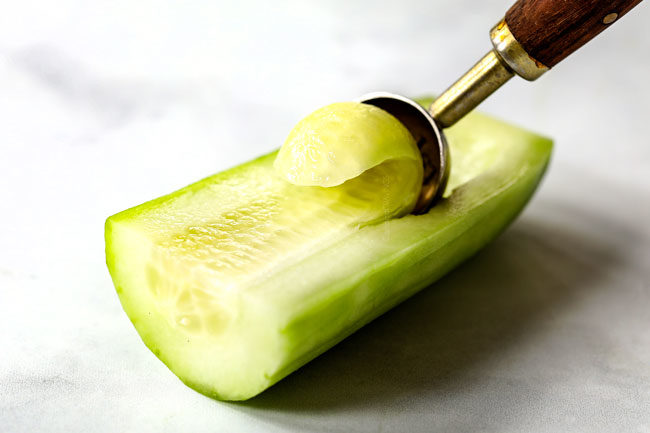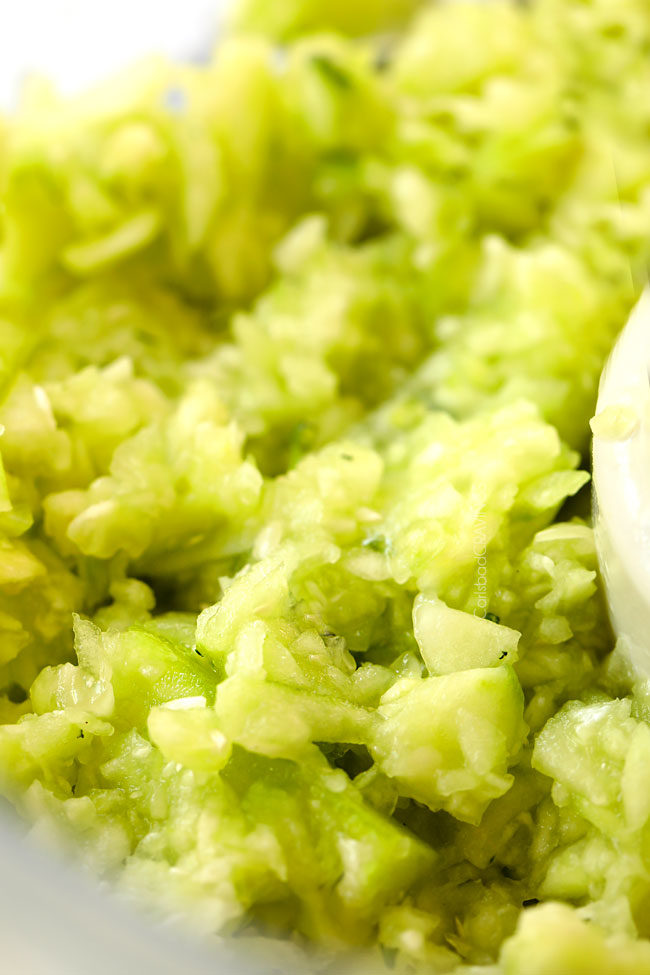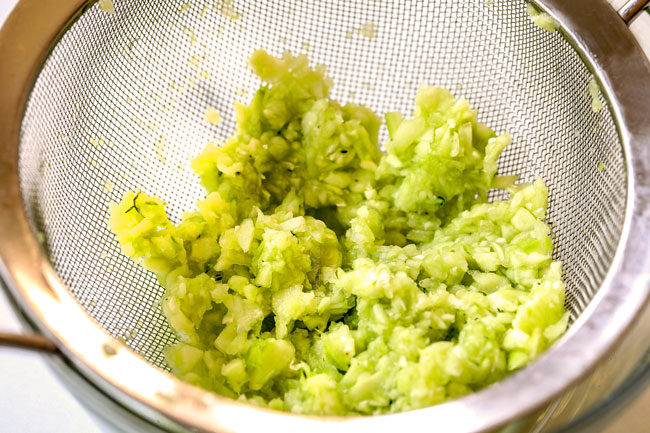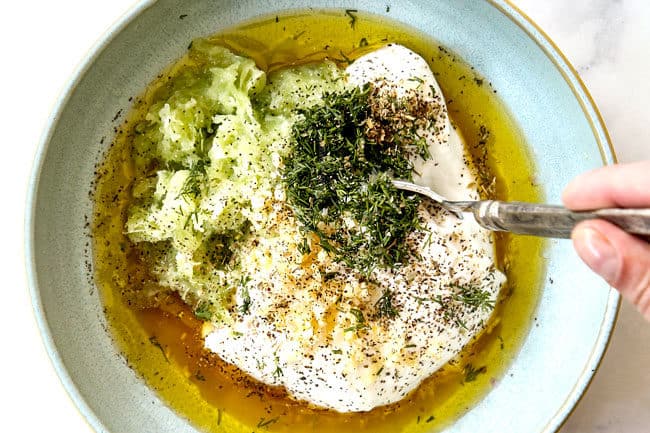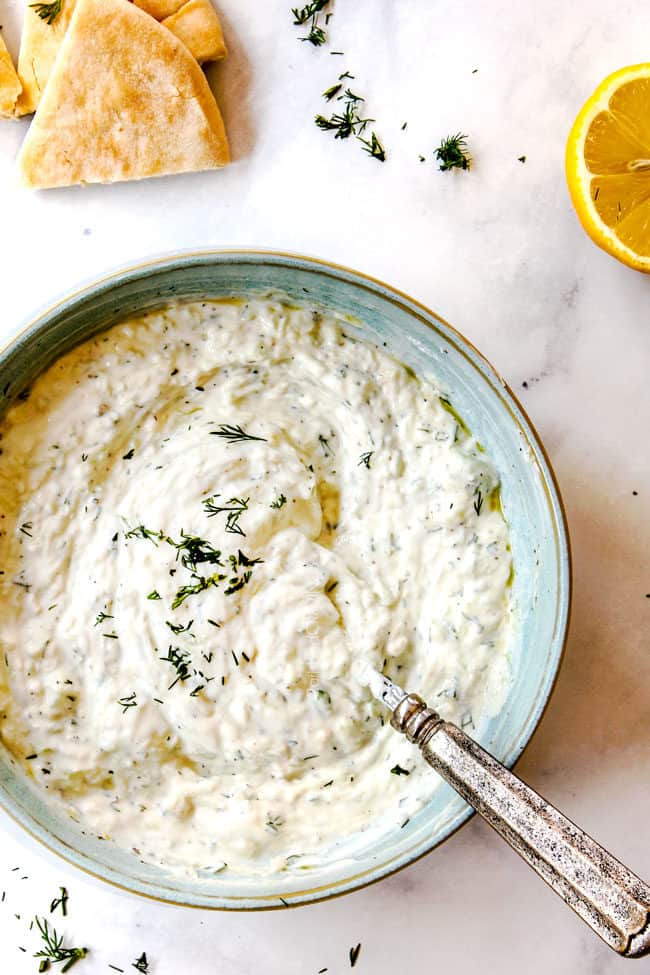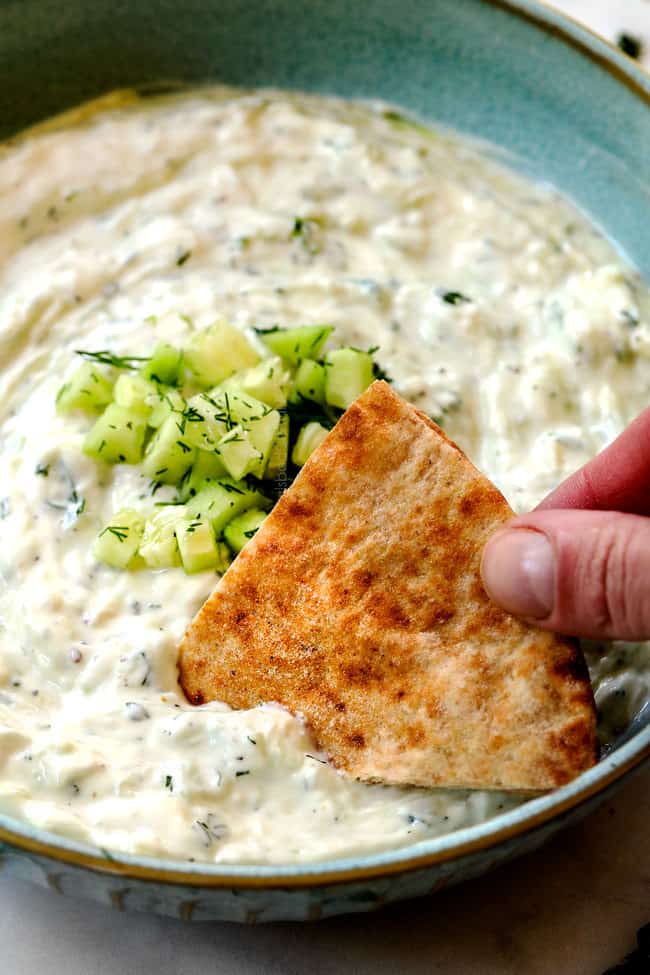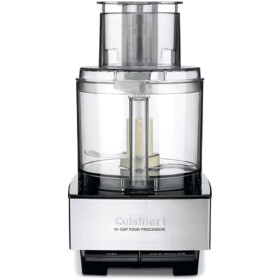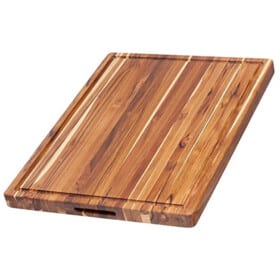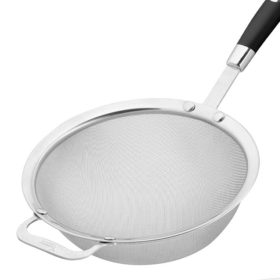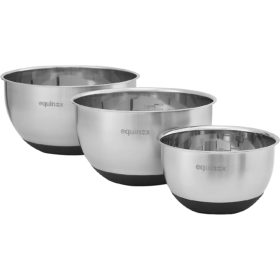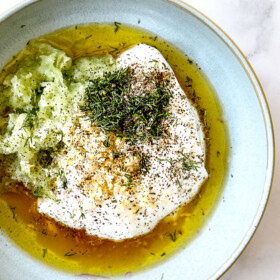Tzatziki Sauce is a versatile condiment that will make all of your Mediterranean recipes better! You can serve Greek tzatziki as a dip for veggies and pitas, as a spread for burgers and sandwiches or as a sauce for all your favorite Greek recipes from souvlaki to gyros. It is make-ahead friendly (actually tastes better with time) so it’s the perfect dip/condiment to have on hand. This tzatziki sauce recipe is made with Greek yogurt, cucumbers, fresh dill, lemon juice, garlic, vinegar, salt and pepper for a crazy flavorful sauce. I’ve also included tips on how to make the BEST tzatziki recipe – NO runny tzatziki, NO bland tzatziki and NO stringy tzatziki!
Watch how to make Tzatziki Sauce
pin this recipe to save for later
This is the Best Tzatziki Recipe
Everyone needs a fabulous tzatziki sauce recipe in their repertoire, and this is it! I’m actually shocked I haven’t posted this recipe before now, just many versions of tzatziki such as tzatziki salad dressing and whipped feta tzatziki – because it makes everything better! So, in preparation for my sublime Chicken Gyro recipe coming up, I bring you equally delicious tzatziki! Patrick and I are obsessed with this recipe. It tastes just like authentic tzatziki and is easy, fresh, vibrant and dippable delicious! It is one of those sauces that tastes fabulously indulgently like hummus because it is SO creamy and makes you want more, more, more BUT it is deceptively healthy; so dip on and dollop on until your belly’s content ;). We love serving this tzatziki sauce with all our favorite Greek recipes, and on wraps such as doner kebabs and chicken shawarma, but we love it just as much as a snack or appetizer with veggies and pita bread. It actually helps me eat ton more veggies because I will use anything I can to shovel the tangy dip into my mouth. So, if you’re looking to eat healthier this summer, OR if you are on the lookout for a favorite potluck dip, this recipe is the answer!
What is Tzatziki Sauce?
If you love Greek food, you are familiar with tzatziki sauce and probably order extra sides of it with your kabobs and gyros. If not, let me introduce you to your new obsession. Tzatziki is a chilled garlicky Greek yogurt and cucumber sauce, dip or spread. It is often associated with gyros but is used for many different dishes. It is made with Greek yogurt, drained cucumbers, garlic, olive oil, fresh herbs (most often dill but sometimes mint or parsley), salt and pepper and sometimes lemon juice.
What does tzatziki mean in Greek?
Although tzatziki sauce is undeniably Greek, the actual word tzatziki comes from the Turkish word cacık (“kind of edible herb”) which in turn comes from the Armenian word cacıg.
Tzatziki pronunciation
Tzatziki is has a lot of letters going on – I have to check my spelling every time! But at least I know for certain how to pounce it: tsaht-ZEE-kee. You can here the correct tzatziki pronunciation here.
Tzatziki Sauce ingredients
Cucumber: Use either ¾ of an English cucumber or 1 slicing cucumber – which is the most common cucumber you see at the grocery store. I recommend peeling and seeding whichever cucumber. Greek Yogurt: Use plain Greek yogurt with any fat content. Whole Greek yogurt will be richer and more flavorful, but nonfat is also creamy if you are trying to save calories. Salt: Good old table salt is necessary to remove excess moisture from the chopped/grated cucumber and to season the tzatziki. Extra virgin olive oil: This adds wonderful body and flavor but is not essential to homemade tzatziki sauce if you are trying to save a few calories. Garlic: Use three minced garlic cloves for a garlicky tzatziki. Use as desired, always starting with less and adding more to taste. Lemon juice: Fresh lemon juice is always preferred, but you may substitute with bottled lemon juice. I suggest starting with one tablespoon and add more to taste for a tangier you tzatziki sauce – OR add some lemon zest. Red wine vinegar: This enhances the tanginess of the lemon juice without adding any bitter notes. If you don’t have red wine vinegar, substitute with additional lemon juice to taste. Dill: This adds the quintessential flavor to Greek tzatziki sauce and should not be omitted or substituted. Use fresh dill for the best flavor. Fresh dill is often sold in small packages in the produce section located next to the other herbs. I recommend starting with one tablespoon fresh chopped dill, then adding more to taste.
Ingredient Tips for Tzatziki Recipe
What type of cucumber should I use? You can use either ¾ of an English cucumber or 1 slicing cucumber – which is the most common cucumber you see at the grocery store. I recommend peeling and seeding whichever cucumber you use, so it really doesn’t matter which one you choose. Some Greek tzatziki recipes don’t call for peeling OR seeding the cucumbers but this will leave you with an unappetizing texture and watery tzatziki unless you let the cucumber drain overnight – and I’m too impatient for that. What yogurt do you use for tzatziki? You must Greek yogurt in tzatziki sauce. Greek yogurt is strained yogurt which makes it much thicker and higher in protein than regular yogurt. If you use traditional plain yogurt, your tzatziki sauce will be too runny. Can I use nonfat Greek yogurt? Yes, you may use either Greek whole-milk yogurt, low-fat or non-fat yogurt in this tzatziki sauce recipe and all will produce excellently thick, creamy results. Do I have to use salt? Yes, you not only need salt for flavor but to help remove excess moisture from the chopped/grated cucumber. You probably won’t not need additional salt once the tzatziki sauce is assembled.
Do I have to use olive oil? Extra virgin olive oil adds wonderful body and flavor but is not essential to homemade tzatziki sauce if you are trying to save a few calories. How much garlic should I add? I use 3 minced garlic cloves for a garlicky tzatziki recipe but you are welcome to add more or less to taste – or start with less and add more. Fresh garlic is one of the cornerstones of authentic tzatziki sauce but you may substitute with ½ teaspoon garlic powder (more or less to taste) if you are in a bind. Can I use bottled lemon juice? Fresh lemon juice is always preferred, but you may substitute with bottled lemon juice. I suggest starting with one tablespoon and add more to taste for a tangier you tzatziki sauce – OR add some lemon zest. What can I substitute for red wine vinegar? I love combining lemon juice with red wine vinegar. It enhances the tanginess of the lemon juice without adding any bitter notes. If you don’t have red wine vinegar, you may substitute with white vinegar or additional lemon juice to taste. Do I have to use dill? YES! Dill adds the quintessential flavor to Greek tzatziki sauce and should not be omitted or substituted. Use fresh dill for the best flavor. Fresh dill is often sold in small packages in the produce section located next to the other herbs. I recommend starting with one tablespoon fresh chopped dill, then adding more to taste.
Tzatziki Sauce variations
Tzatziki can be a springboard for all sorts of recipes – just don’t call the final product tzatziki! Here are some add-in options to try:
Extra lemon, dill and garlic: amp up the entire flavor profile or play up one particular flavor. When adding extra lemon or seasonings, make sure to taste as you go so it doesn’t become overpowering. Finely chopped herbs: parsley, basil, mint, cilantro, chives, etc. can be added in addition to the dill or in place of. For example, try replacing the dill with equal amounts of mint for a minty fresh sauce ideal for lamb or other spicy dishes. Smoked paprika: add 1/4-½ teaspoon smoked paprika for extra smokiness, great for grilled vegetables and meat. Sumac: just a dash will enhance the lemon flavor. Sumac is a tangy, lemony seasoning made from the dried and ground berries of the wild sumac flower; it’s often used in Mediterranean and Middle Eastern cooking. Za’atar: mix it up with Za’aar, an exotic seasoning made from a blend of sesame, sumac, salt and herbs. Everything bagel seasoning: might sound odd, but it’s seriously makes everything better. It’s a simple mix of black and white sesame seeds, dried minced garlic and onion, sea salt flakes and poppy seeds. Harissa: spice it up with up to one tablespoon harissa. Harissa is a Tunisian hot chili pepper paste with strong garlic and lemon notes. The main ingredients are roasted red peppers, Baklouti peppers, garlic paste, caraway seeds, coriander seeds, cumin and olive oil. You could also add a dash of cayenne pepper instead but it’s missing the complexity of harissa. Sun-dried Tomatoes: add ¼ cup of oil-packed sun-dried tomatoes, finely chopped for robust tanginess. Use on wraps, sandwiches, burgers, focaccia, etc. Roasted Red peppers: add add ¼ cup finely chopped drained roasted red bell peppers for smoky, sweet notes. Nuts: sesame seeds, pine nuts or dukkah, a Middle Eastern mixture of herbs, nuts, and spices Feta: stir some salty, tangy feta directly into the tzatziki. Pesto: mixes up the flavor profile with more Italian an flair. Avocado: add one small, ripe avocado for an earthy, cream texture. Make sure to add extra lemon juice and salt to taste.
How to Make Tzatziki Sauce
Everyone loves tzatziki, but unfortunately not everyone knows how easy it is to make! This sauce takes just minutes to whip up and my method uses the food processor so there is no elbow grease and most importantly no stringy tzatziki! The only step that takes any time is draining the cucumber of excess water but this is HANDS OFF time -winning!
Step 1: Prepare cucumbers
Peel cucumbers. You will want to peel the cucumbers no matter if you use an English cucumber or a slicing cucumber. Seed cucumbers. I recommend seeding the cucumber whether you use an English cucumber or a slicing cucumber – this will guarantee your tzatziki sauce will not be runny -and it literally takes 30 seconds. To seed cucumbers, first cut them in half lengthwise. Run a teaspoon down the middle of the cucumber to scrape out the seeds.
Step 2: Chop cucumbers
You have three options when it comes to chopping or shredding your cucumbers. You can pick method 1, 2 or 3 based on personal preference, time and what kitchen tools you have available to you. I have experimented with all three methods and my favorite, recommended method is number 3:
Step 3: Drain cucumbers
No matter what method you’ve chose above, you’ll need to drain the cucumbers of excess water so the tzatziki isn’t watery. The most effective way to do this is in a fine mesh sieve with a sprinkle of salt and not just squeezing with a paper towel.
Add cucumbers to a sieve. I place the sieve over a bowl so the bottom is elevated an inch or so it won’t be sitting in any water once it’s released. Toss with salt. Sprinkle the diced cucumbers with ½ teaspoon salt and give it a good stir. The salt draws moisture out of the cucumbers and allows us to remove the water now instead of it releasing in the tzatziki. You’ll want to let the salted cucumbers rest for 15 minutes OR you can cover the sieve over a bowl with plastic wrap and refrigerate until you’re ready to use, up to 24 hours. Press to release excess. A fair amount of water will release naturally, but after 15 minutes, I like to help the cucumbers along by pressing on them with the back of a measuring cup or spatula. You’ll be surprised at how much more water is released!
Step 4: Combine
Add ingredients to a bowl. Add all ingredients to a medium bowl or serving bowl and give them a good stir to combine. You do NOT want to add everything back to the food processor and pulse because this will make the yogurt runny. You can taste now but I like taste and adjust once the tzatziki has chilled for true serving flavor.
Step 5: Chill tzatziki
Chill for at least one hour. Tzatziki can be eaten right away if you’re short on time, but it hugely benefits from chilling, which allows the flavors to meld together – specifically the garlic, dill and lemon.
Step 6: Serve
Adjust taste before serving. Before serving this tzatziki sauce recipe, taste and add additional dill, lemon juice and salt and pepper to taste. The flavors become less tangy as you let them sit, but the garlic can become punchier so it is best to adjust after chilling. Tzatziki sauce is delicious with any of my serving ideas below.
How to use Tzatziki Dip
This Greek tzatziki enlivens everything it graces with a fresh, tangy, garlic kick. Here are just a few options to serve with tzatziki, but don’t limit yourself to these ideas alone!
Vegetables
You can use tzatziki as a dip for grilled or fresh vegetables. You can even use it as a dressing and toss your vegetables directly in the sauce. It is fabulous with:
Cauliflower Broccoli Carrots Snow or snap peas Bell peppers Asparagus Mushrooms Green beans Salad greens Tomatoes (especially roasted) Roasted zucchini
Appetizer Dip
Pita wedges Pita chips Vegetables (see above) Crackers (I love it with Triscuits)
Spread
On toast On wraps On pita sandwiches On burgers
Sauce
Gyros Greek Pizza Chicken Souvlaki Beef Souvlaki Greek Chicken Greek Salmon or other fish Falafel Lamb Greek rice or quinoa
Best Tzatziki Sauce tips
DO I have to drain the yogurt?
You don’t have to drain your Greek yogurt for tzatziki as quality Greek yogurt is already plenty thick.
DO YOU PEEL CUCUMBER TO MAKE TZATZIKI?
Technically you don’t have to peel English cucumbers, but I find the peel too fibrous in the tzatziki and compromises the texture so I recommend peeling it first.
Can I add other herbs to tzatziki?
Absolutely! I would not omit the dill, but you can add other herbs in addition to the dill such as mint, parsley, oregano and chives.
Can I make this tzatziki sauce recipe ahead of time?
Yes, please do! Tzatziki sauce taste best after the ingredients have had time to meld into each other. Plan on making at least an hour ahead of time but can be made 24 hours ahead of time. You can also chop the cucumbers and leave them to drain in the refrigerator ahead of time so then you just have to toss with the rest of the ingredients.
How long does homemade tzatziki last?
Greek tzatziki should be stored in an airtight container in the refrigerator. When properly stored, tzatziki will last about 5 days, but is freshest within the first 2. After 2 days, the tzatziki will become a little runny as the cucumbers continue to release moisture – nothing to be too concerned about, but just a fair warning. To remedy this, you can stir in a little extra yogurt to absorb the moisture.
Want to try the Best Tzatziki Recipe?
Pin it to your Appetizer, Summer or Healthy Board to SAVE for later!
Find me on Pinterest for more great recipes! I am always pinning :)!
©Carlsbad Cravings by CarlsbadCravings.com Carlsbad Cravings© Original Tag @CarlsbadCravings and Use #CarlsbadCravngs Leave a Review, I Always Love Hearing From You!



